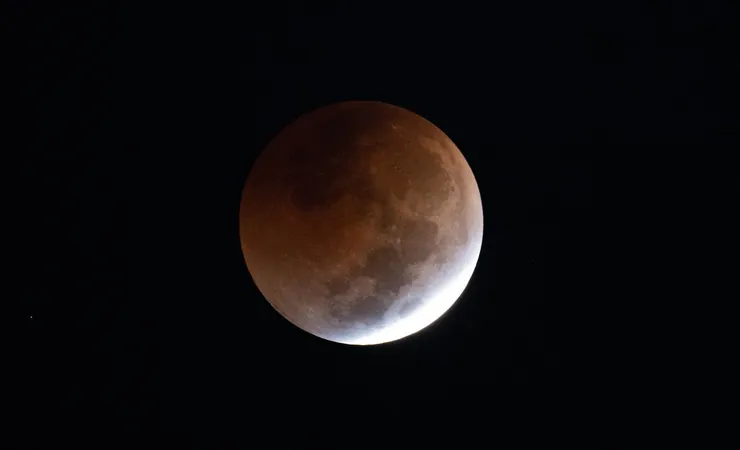
Mark Your Calendars: 2025's Skywatching Spectaculars You Can't Miss!
2024-12-31
Author: Arjun
Get ready, sky enthusiasts! The year 2025 is bursting with breathtaking celestial events that will captivate stargazers of all ages. From meteor showers that light up the night to spectacular lunar eclipses, there are plenty of reasons to look up this year. Here’s a detailed guide to the must-see astronomical events that you absolutely cannot miss!
January 3: Quadrantids Meteor Shower
Watch as one of the most vibrant meteor showers, the Quadrantids, peaks today! From dark-sky locations, you might catch between 60 to 120 meteors per hour. If you're situated on the West Coast of North America, you're in luck as dawn coincides with the shower's peak brilliance. The absence of moonlight means this display will be truly dazzling!
January 9: Moon Hides the Pleiades
Tonight, the waxing gibbous moon will pass in front of the Pleiades Star Cluster, blocking some of its stars temporarily. This cosmic veil will be a treat for observers with binoculars or low-power telescopes, making the reappearance of the stars all the more enchanting.
Winter to Spring: “The Venus Show”
Prepare for a dazzling display as Venus, the brightest planet, graces the evening sky through January and February. In March, it moves closer to the sun but shines once again as a slender crescent during April’s dawn. Make sure to catch this radiant beauty each time it changes position!
January 13: Moon Occults Mars
Don’t miss a rare opportunity when the full moon covers Mars, just days before it reaches opposition! The red planet will shine so brightly it rivals Sirius, making this an incredible sight.
February 6: Another Moon-Pleiades Occultation
The moon will once again obscure the Pleiades cluster in the early morning hours, this time visible mostly from the central and western U.S. Observe as stars fade away only to reappear, creating a stunning spectacle.
March 13-14: Total Lunar Eclipse
Get ready for a mesmerizing total lunar eclipse that favors North America! This celestial event takes place late at night, drawing millions outside to witness the moon’s transformation as it slips through Earth's shadow—an occasion not to be missed!
March 23 - May 6: Saturn's Rings Disappear
A remarkable phenomenon will occur as Saturn’s iconic rings go edge-on to Earth. For over a month, these rings will become nearly invisible—a unique opportunity for astronomers and casual observers alike to witness this rare alignment.
March 29: Partial Solar Eclipse
Mark your calendars! A partial solar eclipse will cover parts of Europe and Africa, with a significant display in portions of northwest Russia and eastern North America. Ensure you have proper solar viewing glasses ready for this event.
June 29: Moon Meets Mars
Catch a beautiful pairing as a waxing crescent moon slides beneath Mars in the evening sky. The view will be breathtaking as they twinkle together in the west-southwest.
July 20: Aesthetic Pleiades Occultation
Witness one of the year's most picturesque moon-Pleiades interactions. As a delicate waning crescent moon dances with this star cluster, binoculars will enhance the magical “DaVinci glow” from Earthshine.
August 11-12: Perseid Meteor Shower & Moonlight
While the bright gibbous moon may hinder visibility, do keep an eye out! You might still catch stunning fireballs and spectacular meteors during this famed shower.
August 11-13: Venus and Jupiter Dance
Experience a breathtaking celestial ballet with Venus and Jupiter rising next to each other in the morning sky over three days. Don't miss their closest approach—only 0.8 degrees apart—on August 12!
September 7: Total Lunar Eclipse
A total lunar eclipse will captivate viewers in Africa and Asia while America will miss out. If you’re in the mentioned regions, prepare to be amazed when the moon takes on dramatic shades.
September 21: Partial Solar Eclipse
Antarctica and New Zealand will get a spectacular show as the moon partially obscures the sun. The best viewing in New Zealand will happen shortly after sunrise, making it a noteworthy event!
November 5: Supermoon Alert
Circle this date for the year's largest full moon! The moon will be exceptionally close to Earth—expect a super bright spectacle as it reaches perigee later in the day.
December 14: Geminid Meteor Shower
Cap off your year with the reliable and stunning Geminid meteor shower. With optimal viewing conditions due to a waning crescent moon, you could see up to 75 meteors per hour! This display is always a highlight so don’t forget your warm clothes as you venture out.
2025 promises to be a phenomenal year for skywatching, so grab your binoculars, set your alarms, and prepare for a celestial journey! Trust us, you won’t want to miss these extraordinary events!

 Brasil (PT)
Brasil (PT)
 Canada (EN)
Canada (EN)
 Chile (ES)
Chile (ES)
 Česko (CS)
Česko (CS)
 대한민국 (KO)
대한민국 (KO)
 España (ES)
España (ES)
 France (FR)
France (FR)
 Hong Kong (EN)
Hong Kong (EN)
 Italia (IT)
Italia (IT)
 日本 (JA)
日本 (JA)
 Magyarország (HU)
Magyarország (HU)
 Norge (NO)
Norge (NO)
 Polska (PL)
Polska (PL)
 Schweiz (DE)
Schweiz (DE)
 Singapore (EN)
Singapore (EN)
 Sverige (SV)
Sverige (SV)
 Suomi (FI)
Suomi (FI)
 Türkiye (TR)
Türkiye (TR)
 الإمارات العربية المتحدة (AR)
الإمارات العربية المتحدة (AR)